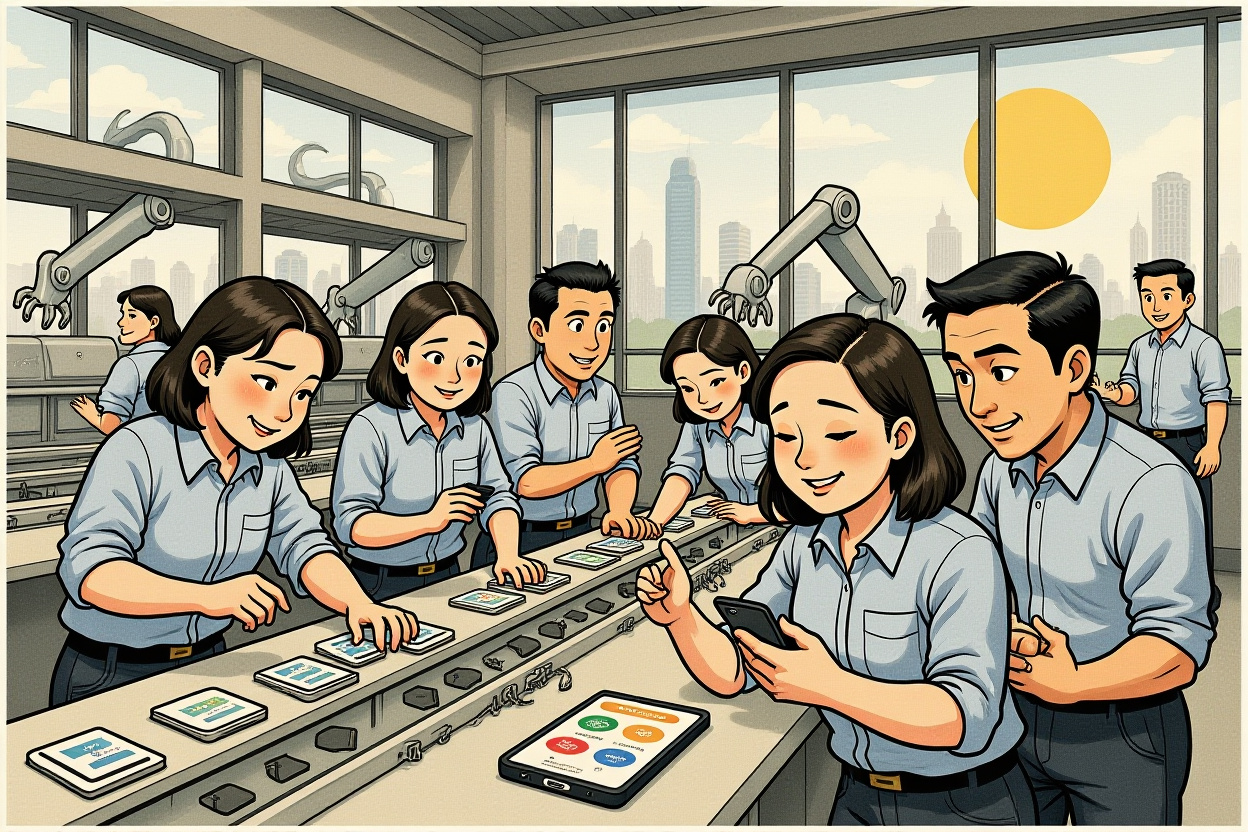The Seasonal Surge in Smartphone Manufacturing
Every year, as summer wanes, a familiar rhythm takes hold across industrial parks in Zhengzhou and Shenzhen. The world’s largest iPhone assembly plants, operated by manufacturing titan Foxconn, shift into high gear. This annual ritual is directly tied to Apple’s product cycle, which traditionally culminates in a September launch event for its latest iPhone models. To meet the immense production demands for these new devices, Foxconn must rapidly scale its workforce, leading to a massive seasonal hiring spree that sees thousands of new workers streaming through its gates daily. This phenomenon offers a unique window into the global supply chain for consumer electronics and the human engine that powers it.
The scale of this operation is staggering. Recruitment centers become hubs of activity, processing a continuous flow of job seekers attracted by temporarily elevated wages and signing bonuses. For many, this period represents a crucial opportunity to earn significant income in a compressed timeframe. The entire ecosystem, from hiring agencies to local businesses that cater to workers, feels the effects of this industrial peak season. It is a finely tuned, albeit intense, machine designed to deliver millions of sophisticated devices to consumers worldwide on a strict deadline.
Decoding the Lucrative Worker Packages
To attract the necessary volume of labor quickly, Foxconn leverages a combination of base pay, overtime incentives, and substantial completion bonuses. The compensation structure is a powerful lure for migrant workers and temporary employees seeking to maximize their earnings.
The Breakdown of a 3-Month, $2,800 Package
The most advertised offer is for so-called ‘return fee workers.’ The deal, prominently promoted on recruitment channels like the Zhengzhou Foxconn Hiring public account, is structured for the peak production season. It includes a base salary of approximately $2100 RMB per month. However, the real draw is the combination of overtime pay and a significant completion bonus. Workers who remain employed for the full 90-day peak period are eligible for a maximum bonus of 8000 RMB, a 1300 RMB stipend, and other subsidies. When all elements are combined, total earnings for the three-month period are projected to fall between 19,200 and 23,000 RMB (roughly $2,650 to $3,170 USD).
For those preferring hourly work, the rates are also competitive. The highest hourly wage reaches 26 RMB per hour, supplemented with a 2 RMB per hour premium and an additional 800 RMB subsidy. These premium rates are often time-sensitive, with recruitment notices stating that ‘this high price is only valid for four days from Sunday to Wednesday,’ creating a sense of urgency to sign up.
Comparing Departments and Factories
Not all positions are created equal. The highest-paying roles are often in the most demanding departments. The A business group (formerly known as iDPBG), which handles iPhone assembly, is a major recruiter. In Shenzhen, the iDPBG department also offers an hourly rate of 26 RMB. Other high-paying departments include the WWW unit, which offers between 27-28 RMB per hour but requires workers to wear sterile suits, and the CNSBG department, which assembles routers for 27 RMB per hour but often involves standing for long shifts. The appeal of the iDPBG and iDSBG (which makes iPad tablets) departments is their reputation for being relatively stable, easier, and offering the chance to work seated, making them highly recommended by hiring agents.
The Unprecedented Scale of Recruitment
The logistical effort to onboard thousands of new employees is a monumental task. Hiring agencies and Foxconn’s own recruitment centers work around the clock to process the influx of applicants, a clear indicator of the immense pressure to ramp up production for the peak season.
In Shenzhen, the Longguan Talent Market serves as a major funnel for Foxconn. Intermediaries at the market report sending hundreds of people to the factory every day. One agent noted, ‘Today we sent one to two hundred people into Foxconn, and加上其他中介送进去的估计有一千多个人 (combined with those sent by other agencies, it’s estimated to be over a thousand people).’ Another agent reported sending several dozen herself. The process is continuous, with workers arriving with luggage in hand, often being transported to the factory in two daily batches around midday for shifts at the Longhua and Guanlan campuses.
The scene in Zhengzhou, Foxconn’s primary iPhone production base, is even more intense. Reports indicate that since the fourth week of July, the Zhengzhou Foxconn recruitment center has been receiving thousands of job seekers daily. On the morning of August 18th, a line hundreds of meters long snaked away from the center, a visible testament to the demand for these temporary but high-paying jobs. This massive mobilization of labor is a direct response to orders from Apple, highlighting the tight integration between product launch schedules and manufacturing capacity.
What Wages Reveal About Production Demand
The fluctuation in wages and bonuses acts as a real-time barometer for Foxconn’s production needs and confidence in order volume. Analyzing these changes provides insight into the health of the smartphone market and anticipated demand for new models.
A clear upward trend in incentives signals high demand. In mid-July, the return fee for the A business group in Zhengzhou was set at 5500 RMB. By the end of the month, it had been raised to 8000 RMB. Furthermore, Foxconn began layering on additional retention bonuses and subsidies on top of this fee, a strategy designed to ensure workers stay for the entire critical 90-day period and reduce costly turnover during peak production. This aggressive increase suggests a strong forecast for iPhone 16 demand, necessitating a large and stable workforce.
However, a broader historical view provides important context. While current packages are attractive, they have actually been higher in previous years. In August 2023, the return fee was also 8000 RMB, but in 2022 and 2021, bonuses soared to 8500 RMB and 10,500 RMB, respectively. The hourly wage in 2022 peaked at 31 RMB, significantly above today’s 26 RMB rate. This comparative analysis suggests that while production is in a旺季 (peak season), the overall pressure might be slightly less intense than in the immediate post-pandemic years, or that Foxconn has become more efficient, requiring a marginally smaller labor force for a similar output. Agents at the Longguan Talent Market anticipate that these premium wages will begin to decrease after this week, with the recruitment旺季 (peak season) concluding by mid-September once production lines are fully staffed and trained.
The Broader Smartphone Market Context
Foxconn’s hiring spree does not occur in a vacuum. It is a direct reflection of the strategies and market positions of its biggest clients, primarily Apple, but also others like Huawei. The health of the global smartphone market directly influences the scale of these seasonal employment waves.
According to data from Canalys, the global smartphone market remains challenging. In the second quarter of 2024, worldwide shipments reached 288.9 million units, representing a slight year-over-year decline. Samsung led the market with a 7% increase in shipments, while Apple, in second place, saw a 2% decrease. The picture in China, a critical market, is even more competitive. IDC reported a 4.1% year-over-year decline in shipments for Q2 2024. The most dramatic shift was Huawei’s resurgence; despite a decline in shipments, its market share climbed to the top spot for the first time in four years. Apple’s shipments in China fell by 1.3%, leaving it in fifth place by market share.
This competitive pressure has forced Apple to adjust its strategy. In May, the company implemented price cuts for the iPhone 16 series in China. Some offline retailers offered discounts of up to 1400 RMB, with even steeper cuts available through online channels. IDC analysts noted that this ‘strategic price adjustment,’ which made certain iPhone 16 and 16 Pro models eligible for government subsidies, helped Apple narrow its shipment decline in the second quarter. This aggressive pricing is a key factor driving the production volume that necessitates Foxconn’s current hiring surge.
Looking Ahead: Innovation and Future Production Cycles
The future of smartphone manufacturing and its associated labor cycles may be on the cusp of change. To reignite growth and differentiate its products, Apple is under pressure to innovate beyond incremental annual updates to its traditional slate-style phones.
Industry speculation is increasingly focused on the potential for a foldable iPhone. While Apple has not officially commented on its roadmap, numerous analysts believe the company is developing a foldable device to compete with offerings from Samsung, Huawei, and Google. Such a product, likely launching in 2025 or beyond, would represent the most significant form factor change in the iPhone’s history. This innovation could serve as a major catalyst for sales, potentially creating even more intense and complex future production peaks for Foxconn and its workforce.
The adoption of new form factors and technologies would also impact the manufacturing process itself. Assembling foldable screens and sophisticated hinges requires different skills and potentially even more meticulous labor than current assembly lines. This could influence future wage structures, training requirements, and the very nature of the seasonal hiring boom, possibly leading to a demand for more specialized temporary workers during the peak production season.
Riding the Wave of Seasonal Manufacturing
The annual migration of thousands of workers to Foxconn’s factories is a powerful spectacle of modern globalized manufacturing. It underscores the immense human effort required to bring cutting-edge technology to market on a mass scale. The promise of earning up to $2,800 in just three months is a powerful incentive, drawing people from across regions to participate in a high-pressure, time-limited industrial sprint. For Foxconn and Apple, this efficient, if intense, system is essential for meeting the enormous demand generated by a new product launch.
This cycle also serves as a key economic indicator, reflecting consumer demand, competitive dynamics, and corporate strategy in the volatile smartphone industry. The ebb and flow of wages and bonuses provide a transparent look into the confidence these giants have in their upcoming products. As the industry looks toward a future potentially defined by foldable screens and new technologies, the relationship between product innovation, market demand, and the workforce that builds these devices will continue to evolve. To understand the real-world impact of a global tech launch, one need only look at the long lines outside Foxconn’s recruitment centers during the peak production season.
What are your thoughts on the scale of modern electronics manufacturing? Do you consider the production process behind the devices you use? Share your perspective in the comments below. For more insights into global supply chains and tech industry trends, explore our dedicated Business section.




